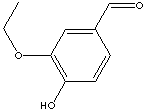|
ETHYL VANILLIN | ||
|
PRODUCT IDENTIFICATION |
||
| CAS NO. | 121-32-4 |
|
| EINECS NO. | 204-464-7 | |
| FORMULA | C2H5OC6H3(OH)CHO | |
| MOL WT. | 166.18 | |
|
H.S. CODE |
2912.42.0000 | |
|
TOXICITY |
Oral rat LD50: 1590 mg/kg | |
| SYNONYMS | 3-Ethoxy-4-hydroxybenzaldehyde; Vanirom; Quantrovanil; | |
| Ethavan; Ethovan; Bourbonal; Ethylprotal; 4-Hydroxy-3-ethoxybenzaldehyde; Protocatechuic aldehyde ethyl ether; Vanillal; 2-Ethoxy-4-formylphenol; 3-Ethoxyprotocatechualdehyde; Ethylprotocatechualdehyde-3-ethyl ether; Ethylprotocatechuic aldehyde; FEMA No. 2464; | ||
SMILES |
c1(cc(ccc1O)C=O)OCC | |
|
CLASSIFICATION |
Pharmaceutic aid, Flavors and Fragrances agent, Perfume ingredient | |
|
PHYSICAL AND CHEMICAL PROPERTIES |
||
| PHYSICAL STATE | White to pale yellow crystals or powder | |
| MELTING POINT | 76 - 78 C | |
| BOILING POINT | 285 C | |
| SPECIFIC GRAVITY |
| |
| SOLUBILITY IN WATER | slightly soluble (2820 mg/l at 25 C) | |
| SOLUBILITY IN SOLVENTS | soluble in alcohol, ether, glycerol and prpylene glycol | |
| pH | acid | |
| VAPOR DENSITY |
| |
|
REFRACTIVE INDEX |
| |
|
NFPA RATINGS |
Health: 1; Flammability: 1; Reactivity: 0 | |
| HENRY'S LAW | 1.10E-10 (atm-m3/mole at 25 C) | |
| OH RATE | 3.27E-11 (cm3/molecule-sec at 25 C Atmospheric) | |
| FLASH POINT |
| |
| STABILITY | Unstable. it turns into dark brown color and loses its flavoring strength in contact with iron, alkali, or light. | |
|
GENERAL DESCRIPTION & APPLICATIONS |
||
|
Vanilla is a plant belongs to the family Orchidaceae, native to tropical
American forests. Both V. planifo¢lia Andr. (Mexican or Bourbon vanilla) and V.
tahiten¢sis Moor (Tahitian vanilla) have fruits called vanilla beans which are
picked before fully matured. Vanilla is a choice of flavoring agnet prepared
from vanilla beans with or without the addition of sugar, dextrose, or glycerol.
Vanilla extract contains soluble matter from not less than 10 grams of vanilla
beans in 100 milliliters. Vanillin (chemically 4-hydroxy-3-methoxybenzaldehyde)
is a constituent of vanilla or is prepared synthetically.
Vanillic acid: the oxidation form of vanillin. The chemical designation is 4-hydroxy-3-methoxybenzoic acid. Ethamivan: the diethylamide of vanillic acid; used as a central nervous system stimulant, respiratory stimulant, and analeptic. Ethyl vanillin: white to pale yellow crystal; melting 76.5 C; having 3.5 times stronger flavour and more stable in organic solvents and in storage than vanillin but does not have the true flavour. It is used in pharmaceutical preparations and the food industry as a flavoring agent to replace or strengthen vanilla. Acetovanillon: white crystal a faint vanilla odor; melting point 115 C; soluble in hot water, alcohol, benzene, chloroform, and ether; used as a cardiotonic drug. Chemical naming is 4'-Hydroxy-3'-methoxyacetophenone. http://sci-toys.com/ http://www.ajevonline.org/ http://www.fantastic-flavour.com/ |
||
| SALES SPECIFICATION | ||
| APPEARANCE |
White to pale yellow powder | |
|
PURITY (G.C.) |
98.0% min |
|
MELTING POINT |
76 - 78 C |
|
|
LOSS ON DRYING |
0.5% max |
|
|
HEAVY METALS |
10ppm max |
|
| TRANSPORTATION | ||
| PACKING | 25kgs
in bag | |
| HAZARD CLASS | ||
| UN NO. | ||
|
PRICE INFORMATION |
||
